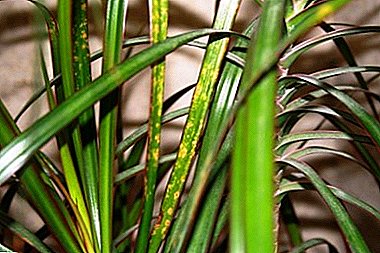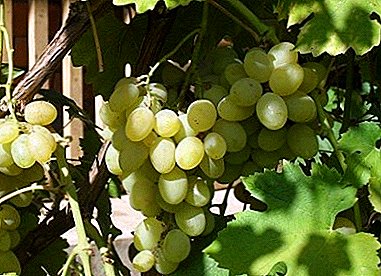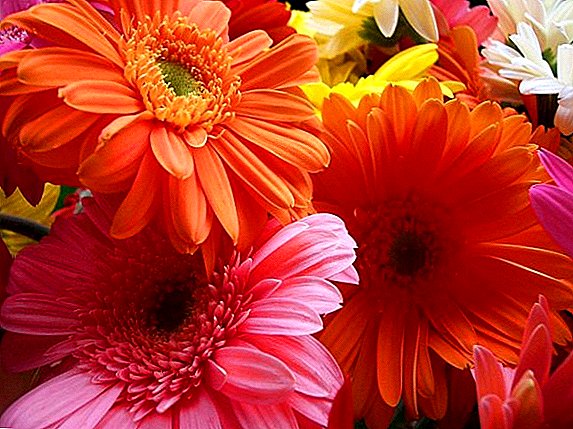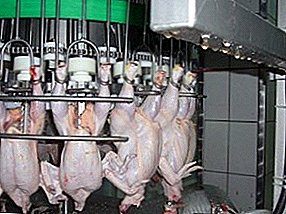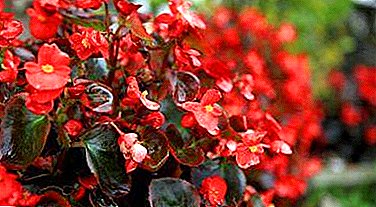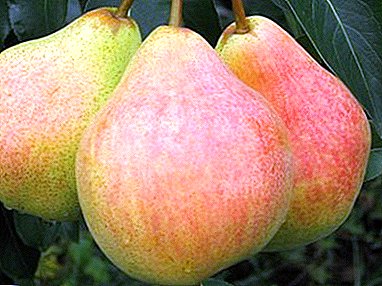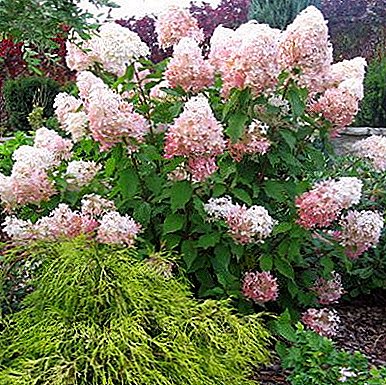
Common name "hydrangea" These plants received 300 years ago in honor of the princess who bore such a name. Kind of "princesses" with paniculate buds in the flowering season publishes a wonderful fragrance.
Smell the same way panicle hydrangeas at home, in Japan, China and Sakhalin, where they grow as perennial deciduous bushes and trees up to three meters high.
Thanks to the painstaking and lengthy selection, frost-resistant plants with luxurious, white and pink flowering were obtained from the original forms.
Varieties that can withstand thirty-degree cold, successfully develop and bloom profusely in the open ground of the middle band.
Open field maintenance
Choosing a place
Adult plants of this species do not tolerate transplantation, so the place on which the seedling will grow and develop should be permanent.
Landing site should be protected from strong wind and well lit; slight shading possible.
The landing site should not be endangered from the roof of the snow layers: fragile wood will not withstand the additional load.
Priming
The soil should be slightly acidic, moderately loose and sufficiently nutritious.
Its composition may be as follows: peat, humus, turf, leaf soil and sand in equal quantities.
Also used is an "equidistant" mixture of peat, humus and garden soil.
 Landing
Landing
The best time to land in open ground - Spring. Bushes, wintering in the ground, can be planted immediately after thawing of the soil, and greenhouse, with leaves - only in late spring, at the end of frosts.
Planting pit size should provide sufficient space for the growth of the root system of the seedling. The usual dimensions are from 0.5 to 0.8 meters in length and width. The depth may be a little less, as the roots of paniculate hydrangeas grow more in breadth than in depth.
If the soil is clay, a drainage layer of pebble, expanded clay, brick or ceramic paving is laid on the bottom.
Sandy soil, in contrast, compacted with a layer of clay at the bottom of the planting pit.
If groundwater is high, landing on a hill is a must.
A layer of soil mixture and a carefully spread moist root system are placed in the prepared landing pit.
Dust the soil, carefully sealing it. As a result root neck should be flush with the soil surface - but not deeper.
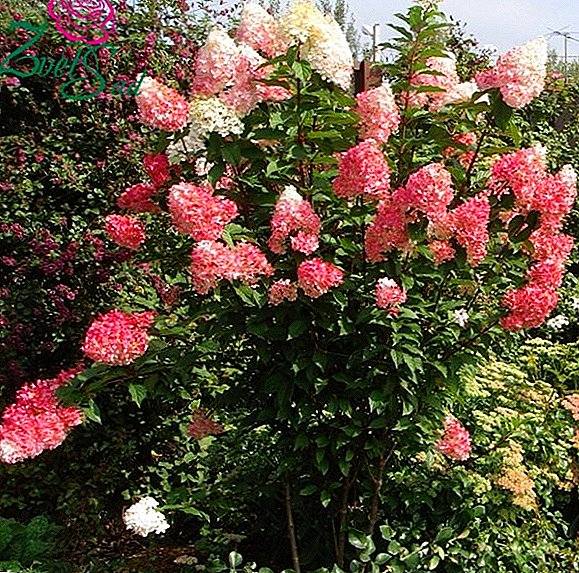 Watering
Watering
Optimal irrigation water should be soft, ideal - rainwater irrigation.
Water from the water supply network should be well settled and warmed up, and from time to time it is useful in it. add a small amount of lemon juice or vinegar.
Paniculate hydrangea, unlike many other species of this plant, is relatively drought-resistant, but in the dry summer systematic abundant watering is necessary.
Top dressing
The plant responds well to the mineral fertilizing complex for heather, rhododendrons and azaleas. The best option - special mixtures specifically for hydrangeas. They can be from time to time supplement with organic compounds.
Terms of fertilizer application take into account the main phases of growth and development:
- spring feeding promotes the formation of young shoots;
- June promotes abundant bud formation;
- summerIn the heyday, it prolongs flowering and takes place twice a month. In these feedings should be added potassium and phosphorus components, and the nitrogen - to reduce.
- Autumn, before the dormant period, consists of superphosphate and potassium sulfate.
Pruning

These fast growing bushes can and should be subject to pruning in the fall and spring, as the flower buds are revealed on the shoots of the current year.
Moreover, heavy pruning to the level of four to six or even to two or three kidneys stimulates the mass formation of powerful shoots with large buds.
Sophisticated pruning also helps to form this hydrangea as attractive trees.
In this case, on a young plant, choose a vertical leading shoot and 4-5 side shots, cut out the remaining shoots, leave the side shoots and give the “leader” to grow by 1-1.5 meters.
After that, its top is cut off, stimulating the formation of skeletal branches of the crown, and the lateral "support" is removed.
How to cover for the winter?
Adult panicled hydrangeas do not need a winter shelter, but young plants it is better bend down and spruce up.
For mature busheshaving fragile wood danger of heavy snowfall.
So that the branches do not break off, they are tied together and attached to a reliable support.
Bloom
The abundant flowering of fragrant "sweeper" begins in mid-summer and lasts until the autumn
Coloring inflorescences depends on their age (the older, the rosier) and soil acidity: white in neutral soil flowers get pink shades in sour substrate.
This property is widely used, especially since acidified, soft water is beneficial to plants.
Some varieties at a young age do not form lush inflorescenceshowever, with age, flowering increases and reaches its proper form.
Blossoming "panicles" are long cut. Even when dried, they retain their shape, color, and partly aroma.
Required pruning of all inflorescences to the first heavy snowfalls, as heavy snow caps on these "panicles" will create a load that can become unbearable for fragile branches.
Breeding
 The seeds of paniculate hydrangea often do not ripen in the middle lane, and their germination does not last longer than a month. Therefore, multiply it vegetatively: layering and cuttings.
The seeds of paniculate hydrangea often do not ripen in the middle lane, and their germination does not last longer than a month. Therefore, multiply it vegetatively: layering and cuttings.
Reproduction by layering. In the spring or at the end of summer, a suitable branch is bent to the ground, fixed in the middle, slightly buried and dropped in this place. The top of the branch is tied to a support in order to give it a vertical position. Over the year, the prikatannaya part forms a sufficient root system, after which a new plant can be separated from the parent.
Reproduction cuttingsand. This method has two optimal periods: spring, in which cuttings are harvested from waste after pruning and summer, June.
- Spring cuttings for 3-5 internodes, they are cut from selected branches, previously aged in water for two or three days. The lower sections are treated with a root formation stimulator and planted in a mixture of sand and peat, deepening about two-thirds of the length. Planting cover with plastic film, moisturize, air and contain at a temperature of 14-17 degrees. Rooting occurs usually within a month.
- Summer cuttings - more risky material for rooting, as at this time the plant tissue contains much less moisture. However, the period from 10 to 15 June is considered the most successful for this type of breeding. The material for ten-centimeter cuttings are young shoots without flower buds in the lower part of the bush. They break out with the "heel" and process the core at the fracture of the root stimulator. Retain 3-4 top sheet, and lower remove. Planted in the ground and cover; maintain humidity, air and, before the formation of the first new shoots, protect from direct sunlight. Rooting usually takes 20-30 days.
Diseases and pests
Hydrangea on the site with optimal conditions for it is resistant to disease.
If a soil is limestone or supersaturated with humus, a plant can develop chlorosis, in which the leaves, with the exception of the central vein, become izhelta-light.
In this case, spend watering potassium nitrate solution with a concentration of 4g / l, and after 3 days - ferrous sulfate solution the same concentration.
 Downy mildew, in which dark oily, gradually spreading spots are formed on the leaves and stems, affects the hydrangea at a temperature of 18-20 degrees in combination with high atmospheric humidity.
Downy mildew, in which dark oily, gradually spreading spots are formed on the leaves and stems, affects the hydrangea at a temperature of 18-20 degrees in combination with high atmospheric humidity.
An effective remedy for this disease is spraying with copper-soap solution: 15 g of copper sulfate and 150 g of green soap on a bucket of water.
Gray rotthat also develops in summer with high humidity, requires the removal of affected leaves and shoots and the treatment of the bush fungicides.
If the humidity is low, the plant can settle aphid and spider mitesthat can be removed with soapy water.
However, the most effective in such cases, the use of systemic insecticides.
As a preventive measure, one should get rid of weed vegetation serving as a haven and breeding ground for these pests.
Paniculata hydrangea - one of the most unpretentious and hardy "princesses" open ground. She is can withstand not only the winter cold, but also a significant pollution of the atmosphere.
A suitable planting place, easy maintenance and sufficient watering will ensure a long, perennial, fragrant flowering of these bushes-trees in the open ground conditions of the middle lane.
A photo
Photo hydrangea paniculata, see below:







 Landing
Landing Watering
Watering